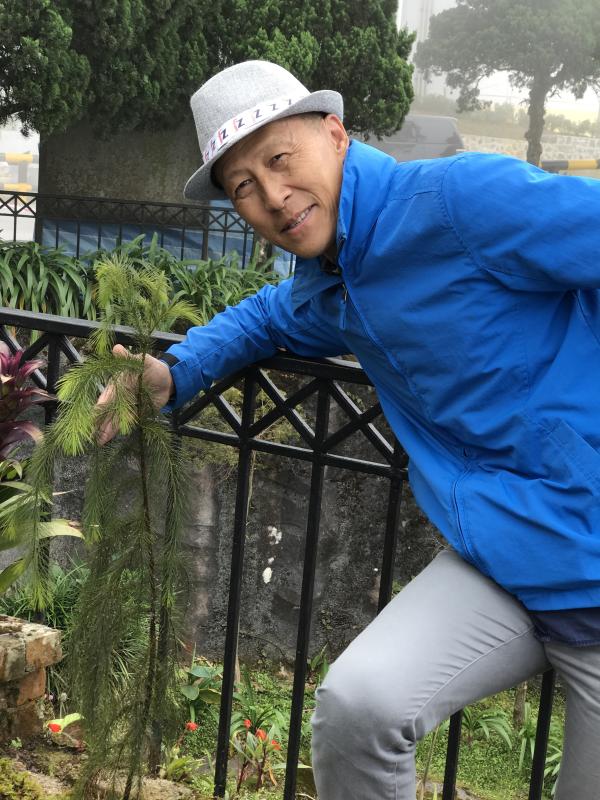#TeamMayLee: Captivated by conifers
Did you know, there is a species of coniferous trees native to Malaysia? #TeamMayLee learnt that and so much more! Full story: rage.com.my/teammaylee-captivated-coniferous-trees/
Registration for our December camp is now open, so what are you waiting for? Log on to rage.com.my/bratsrecruitment, and you could be part of our #BRATsfam!
Posted by BRATs on Wednesday, 27 September 2017
By TEAM MAY LEE

Chan posing with a newly-replanted coniferous seedling.
IN the mountain regions of Genting Highlands, Pahang, grows the Dacrydium Comosum, a native species of coniferous plants, small in number and endangered.
Due to rampant development, the number of the coniferous plant has decreased. The issue is unknown to many as there is little awareness of the problem. However, through the efforts of Eddie Chan Teck Ling, a nature conservationist, the coniferous trees are making a comeback as he works hard to save them.
It all started with a survey led by Chan and his team from Treks Nature Enterprise, which led them to conclude that the dacrydium comosum was the most endangered, resulting in the launch of a personal project to protect the trees. The project, he believes, will inspire and influence the Genting Highlands management to get involved in restoring the trees.
“I believe they will, if we do it (the project) right,” said the 58-year-old. “This is why Treks is here.” Chan and his team protect the trees through resettlement, a process whereby the plants are transported from an area that endangers them to a safe area for them to grow, away from any possible threats.
The concept sounds simple enough but the execution proves otherwise. “It doesn’t just take a little time to resettle these plants but a lot of effort, especially since these trees are such slow growers.”
It is a race against time as Chan and his team try to save the trees in time before they become lost. The plants are resettled in the Talking Garden, which is a conservation effort by Chan and his team.
The Talking Garden is a technology integrated garden that provides information about the plants within the garden. The garden contains posters with QR codes and NFC (near-field communication) tags that provide educational videos about the plants when scanned.
The convergence of nature and technology has provided efficiency as it is easily accessible on most smart devices. It is also education on-the-go as the information can be saved to be consumed later. “The garden saves so much time and effort as tour guides don’t have to repeat their explanations again and again.”
The Talking Garden provides the stories about the resettled plants, allowing all those who visit the garden to learn about them. Though Chan’s efforts seem small, he has already managed to save four seedlings through settlement. The seedlings are now growing healthily as he keeps an eye on the plants.
Not only does Chan save the coniferous trees from developing areas, but he saves them from slopes, as well. As seedlings grow on slopes, danger creeps up on them due to grass cutting. Therefore, Chan resettles the plants to areas of habitable environments.
Another way he hopes to protect the trees is through learning about the plants in order to grow them from spores in a nursery to ensure the trees grow in quantity.
He is confident that the management at Genting Highlands will do everything in their power to protect the trees as “there is a general understanding that Genting has a strict policy of keeping nature intact.”
The policy is evident through the many security checkpoints within Genting Highlands that are set up to prevent problems like poaching.
The dacrydium comosum also serves an ecological purpose. It is the only nesting tree of the Brown Blue Finch bird that has not been seen since 1991. The decreased number of trees has resulted in the disappearance of the birds from Malaysia.
However, Chan remains hopeful. “If we were to resettle and grow them back in large numbers, we might see them coming back. “I believe that the coniferous trees will no longer be further endangered as long as development does not continue surrounding the habitats of those trees.” As Chan’s efforts continue, he hopes for awareness to grow.
With the awareness, he believes he is able to devise an action plan such as rescuing the coniferous trees within developing areas. When asked why he carries out the project, he replied: “If we can make an effort – a really worthwhile effort – to resettle them, reproduce them, and put them back into the wild, why not?”


Tell us what you think!